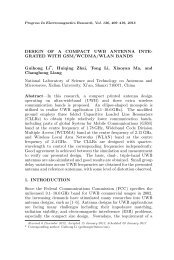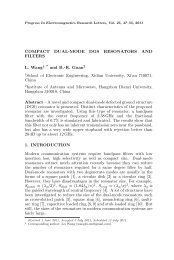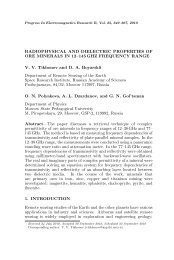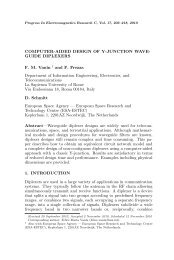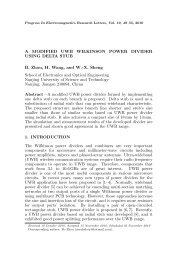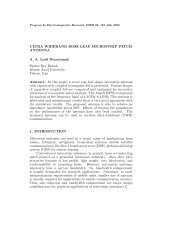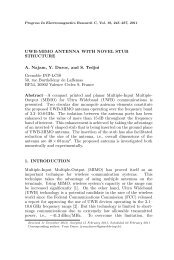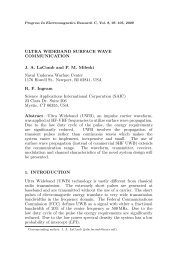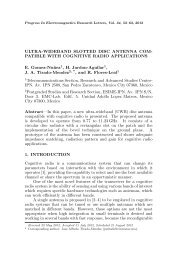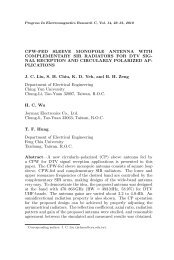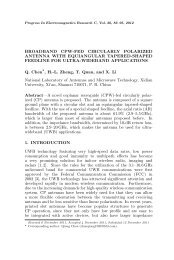LINEAR AND CIRCULAR ARRAY OPTIMIZATION: A STUDY ... - PIER
LINEAR AND CIRCULAR ARRAY OPTIMIZATION: A STUDY ... - PIER
LINEAR AND CIRCULAR ARRAY OPTIMIZATION: A STUDY ... - PIER
You also want an ePaper? Increase the reach of your titles
YUMPU automatically turns print PDFs into web optimized ePapers that Google loves.
360 Khodier and Al-Aqeel<br />
Gain (dB)<br />
0<br />
-5<br />
-10<br />
-15<br />
-20<br />
-25<br />
-30<br />
-35<br />
max(SLL) = -16.2037<br />
PSO<br />
Conv.<br />
-40<br />
0 20 40 60 80 100 120 140 160 180<br />
Phase [deg]<br />
350<br />
300<br />
250<br />
200<br />
150<br />
100<br />
2 4 6 8 10 12 14 16 18 20<br />
Azimuth angle (deg)<br />
Element #<br />
(a) (b)<br />
Figure 13. (a) Radiation pattern of 20-elements linear array<br />
optimized with respect to phases ϕn’s to minimize the maximum SLL<br />
and radiate towards φd = 45 ◦ with ∆φd = 22 ◦ . (b) The corresponding<br />
element phases compared with λ/2 spaced conventional array steered<br />
towards φd = 45 ◦ .<br />
3. <strong>CIRCULAR</strong> <strong>ARRAY</strong> <strong>OPTIMIZATION</strong><br />
The PSO method is also employed to determine an optimum set of<br />
weights and/or antenna element separations to create a non-uniform<br />
circular isotropic array that maintains low side lobes. Also, dipole<br />
circular arrays are widely used in communication systems as the<br />
components for signal receiving [58]. Therefore, circular dipole array<br />
are also considered here to determine the optimum set of excitations,<br />
antenna elements separations and dipoles lengths.<br />
3.1. Isotropic Circular Array<br />
We consider isotropic circular array and optimize the radiation pattern<br />
of the array in the term of the SLL reduction. The PSO algorithm<br />
is used to determine the complex weights αn and/or the separation<br />
between elements dmn where n = 1, . . . , N and N is the total number<br />
of elements in the array. The array geometry is shown in Figure 14 for<br />
an array of N elements. The array factor for such array is given in [59]<br />
as:<br />
AF (φ, α, dm) =<br />
N�<br />
n=1<br />
50<br />
0<br />
j(ka cos(φ−φn))<br />
αne<br />
(9)<br />
αn = Ine jϕn (10)





